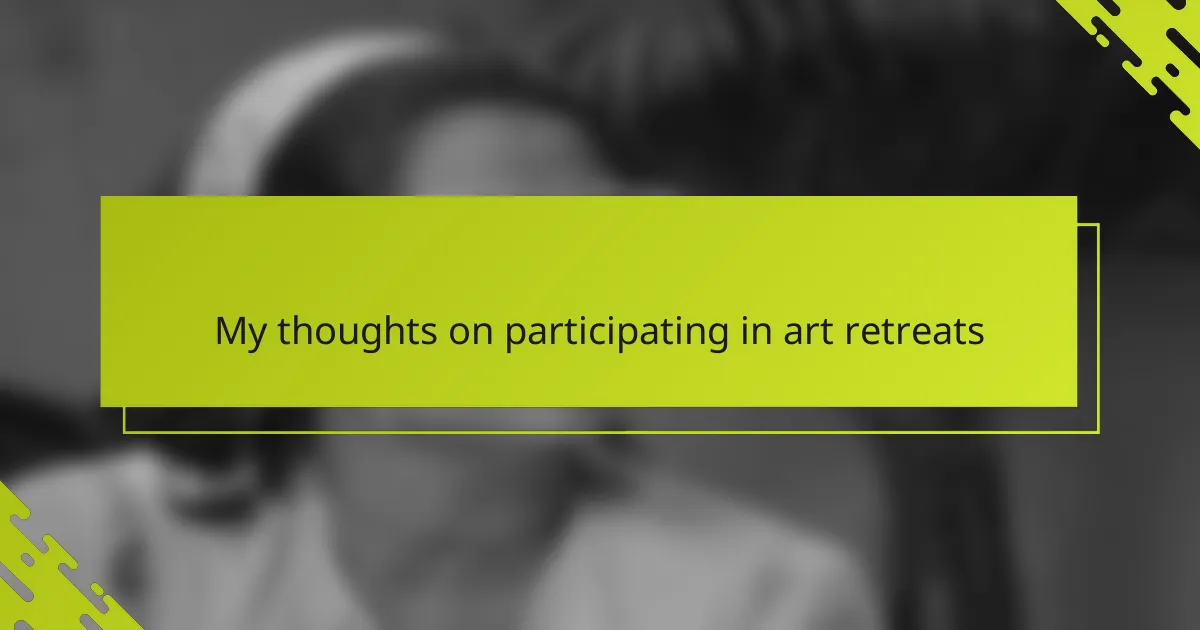Key takeaways
- Art retreats foster creativity by providing a supportive environment for personal growth and community connection.
- These spaces allow for exploration of identity and encourage open dialogue, enhancing artistic expression.
- Participating in retreats can dissolve barriers, enabling artists to experiment freely and share vulnerabilities.
- Challenges in art retreats can lead to growth, as embracing imperfection and open communication enhances connections.
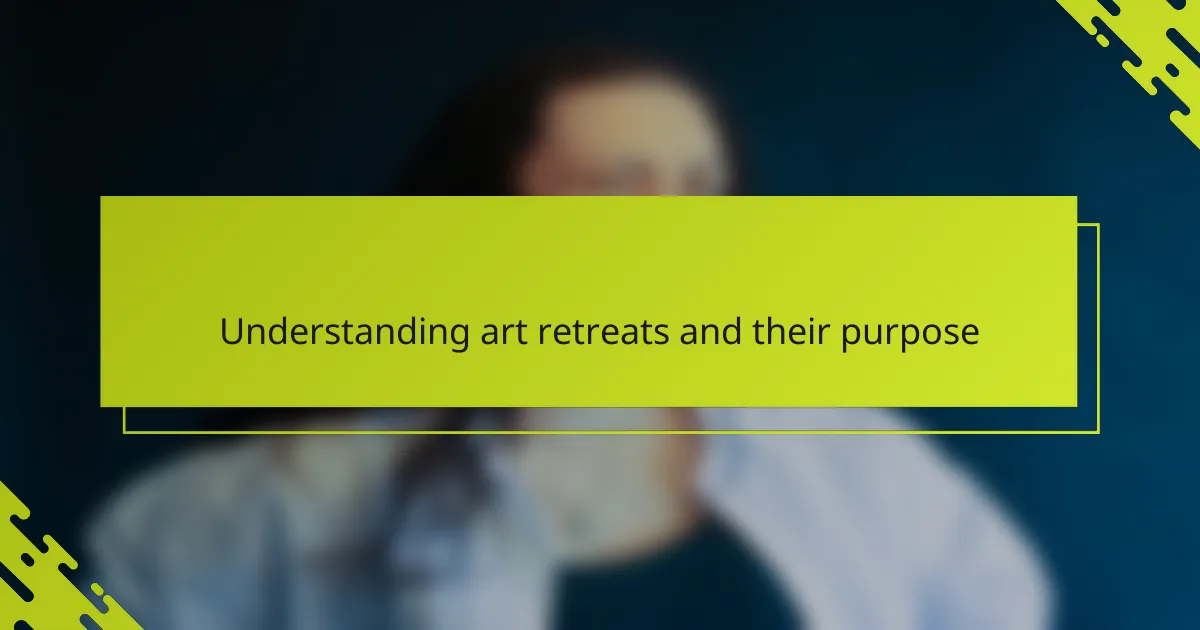
Understanding art retreats and their purpose
Art retreats are more than just a break from routine; they’re intentional spaces designed to nurture creativity and self-expression. I’ve found that stepping away from daily distractions in such a setting opens up a kind of creative flow I don’t encounter elsewhere. Have you ever noticed how changing your environment can suddenly unlock ideas you didn’t know were there?
At their core, these retreats aim to provide time and space for artists to connect deeply with their craft and with others who share that passion. When I participated in my first retreat, I was surprised by how the communal aspect fueled my inspiration—it wasn’t just the solitude but the shared energy in the room that mattered. This balance between quiet reflection and collaborative exchange is something I now look for in any creative experience.
Ultimately, art retreats serve a dual purpose: fostering personal growth and building community. I often reflect on how being in a supportive, immersive environment helped me embrace vulnerability through my work. Isn’t it powerful to consider that creativity thrives not only in isolation but in the company of others who understand your journey?
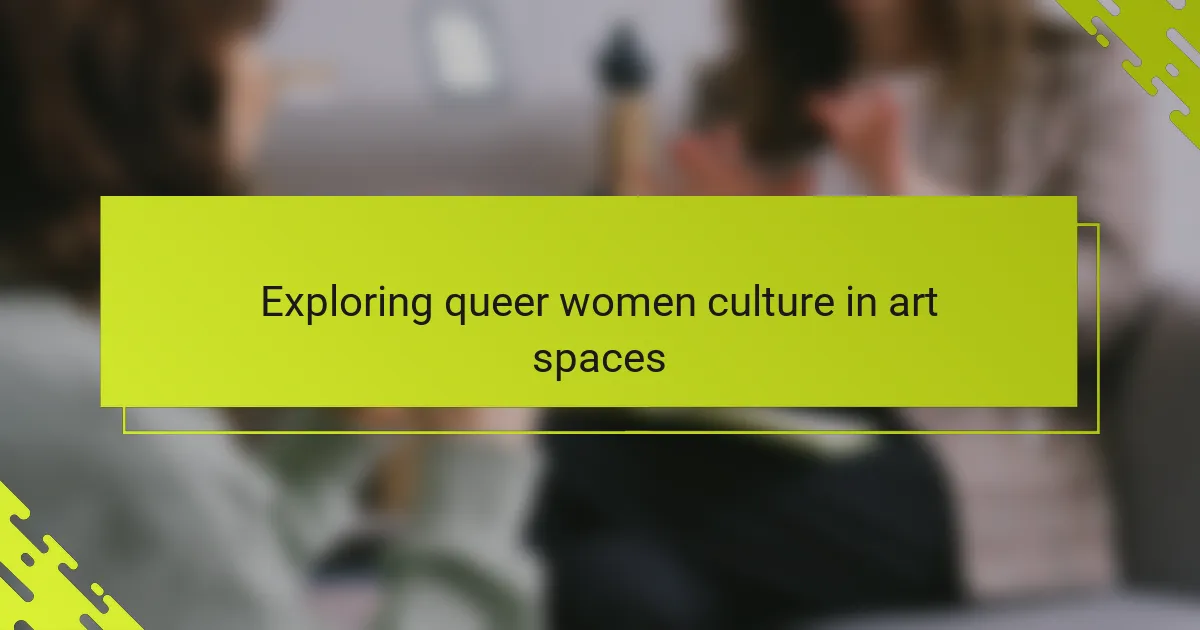
Exploring queer women culture in art spaces
When I first encountered queer women culture unfolding within art spaces, I was struck by how these environments become sanctuaries where identity and creativity intertwine. It’s more than just making art—it’s a way to explore and celebrate the nuances of our lived experiences without fear or judgment. Have you ever stepped into a room where every brushstroke feels like a piece of a shared story?
What I appreciate most is how these spaces encourage dialogue that’s both open and deeply personal. I remember during a retreat, hearing someone articulate feelings about visibility and belonging that resonated so strongly with me, it shifted the way I approach my own work. It’s in these moments that art becomes a powerful medium for connection and healing.
Exploring queer women culture in art spaces is an invitation to challenge mainstream narratives and carve out new ones that speak to us authentically. The energy in these retreats is electric, a mix of courage and compassion that pushes creative boundaries. Isn’t it amazing how such spaces can transform not just our art, but our very sense of self?
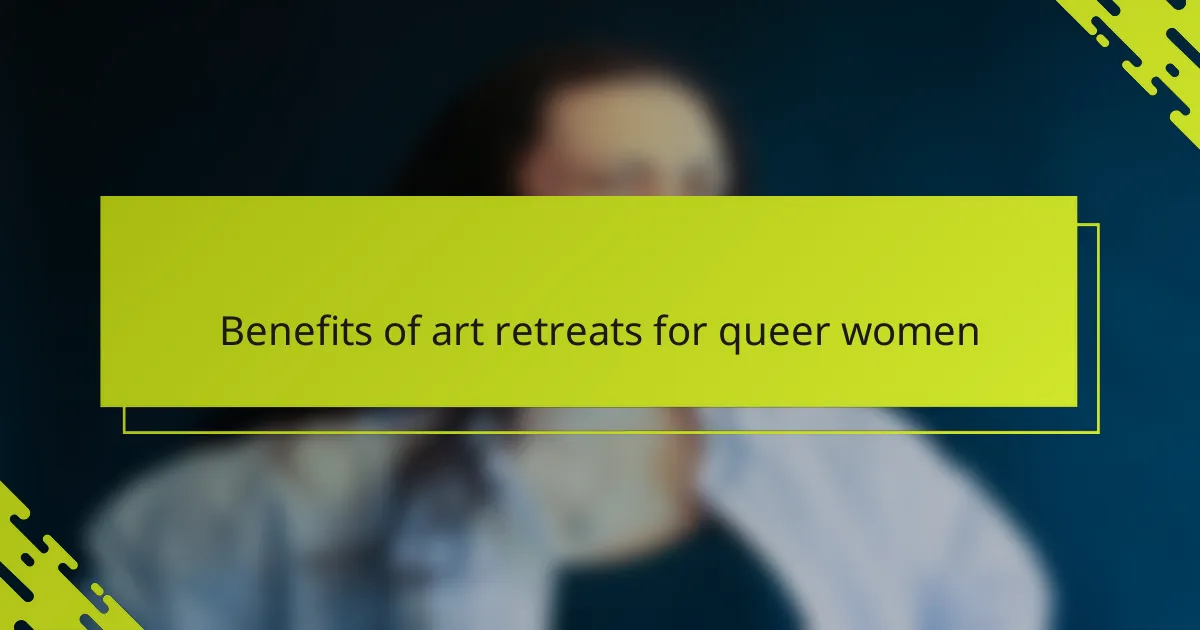
Benefits of art retreats for queer women
One of the most profound benefits I’ve experienced in art retreats for queer women is the sheer sense of belonging. Surrounded by people who truly see and honor my identity, the usual walls I put up around my creativity just dissolve. Have you ever felt that instant comfort that lets your authentic self shine through your work without hesitation?
Another priceless aspect is the freedom to experiment without judgment. In these retreats, I found myself pushing artistic boundaries I never dared to cross before, fueled by the collective encouragement and understanding in the room. It’s like our shared identities create a safety net that catches our boldest ideas and lets them take flight.
Lastly, there’s a healing quality to the communal creativity that sticks with me long after the retreat ends. Being with others who navigate similar struggles through art reminded me that I’m not alone in weaving my story. Have you noticed how expressing yourself among kindred spirits can transform vulnerability into strength?
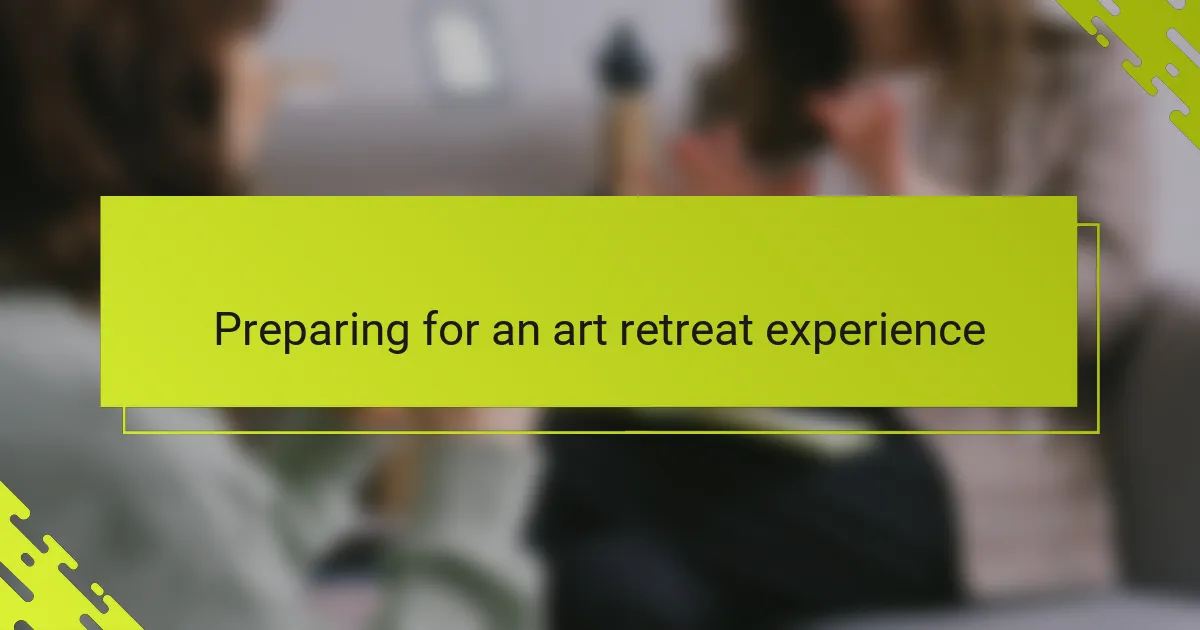
Preparing for an art retreat experience
Preparing for an art retreat means more than packing your art supplies—it’s about setting an intention for what you want to explore creatively and emotionally. Before I leave, I like to reflect on where I am in my artistic journey and what kind of breakthroughs or connections I hope to invite. Have you ever thought about what you truly want to get out of that time away?
Choosing the right materials can feel both exciting and a bit overwhelming. I’ve learned to bring a mix of familiar tools and new ones that spark curiosity, so I have the freedom to experiment without feeling stuck. It’s like creating a little creative comfort zone you can carry with you.
I also try to prepare mentally by easing expectations and reminding myself that the retreat is a space for growth, not perfection. Sometimes I journal a few thoughts or worries beforehand—that way, I arrive open and ready to embrace whatever the experience brings. How often do we give ourselves permission to just show up as we are?
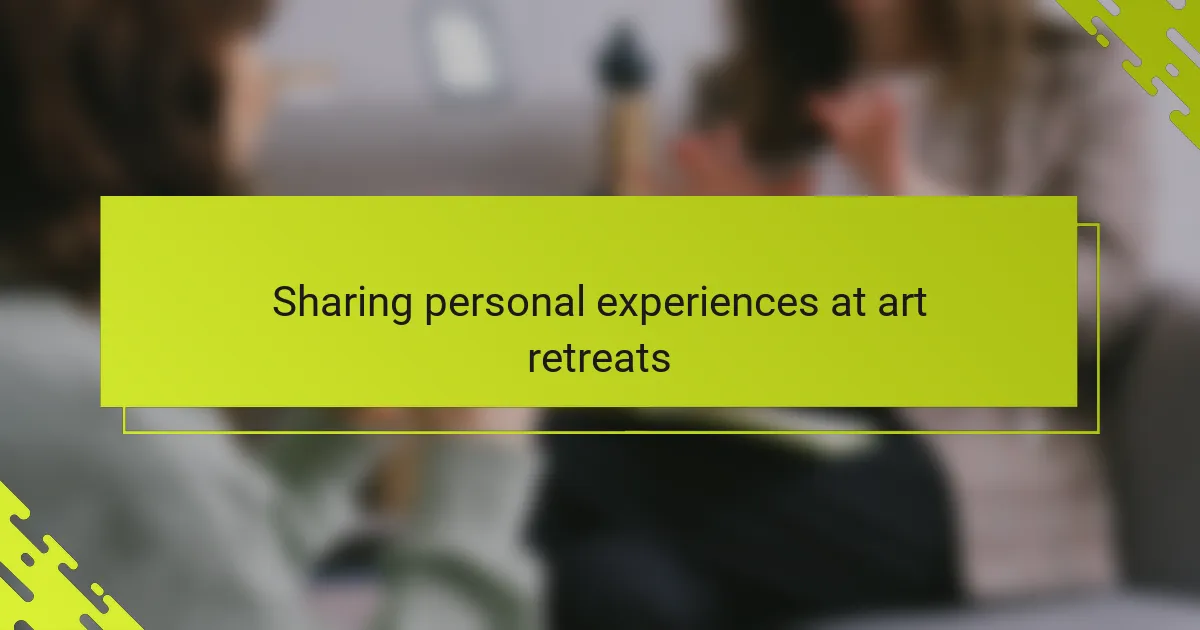
Sharing personal experiences at art retreats
Sharing personal experiences at art retreats often becomes a cherished highlight of the whole journey. I remember one retreat where, during a casual sharing circle, a fellow artist’s story about reclaiming her voice through painting touched me deeply. It made me realize how much my own work is intertwined with the stories I carry inside.
There’s something uniquely powerful about opening up in those moments—vulnerability becomes a bridge rather than a barrier. I’ve found that when I share my experiences, it invites others to do the same, creating a ripple effect of empathy and understanding that enriches the creative process. Have you experienced that kind of intimacy in a creative setting before?
Sometimes, sharing goes beyond words; it’s in the gestures, the unfinished sketches, or the way someone’s eyes light up talking about a breakthrough. At an art retreat, those small, genuine exchanges often carry more weight than formal critiques. Don’t you agree that authenticity feels like the heart of any meaningful artistic community?
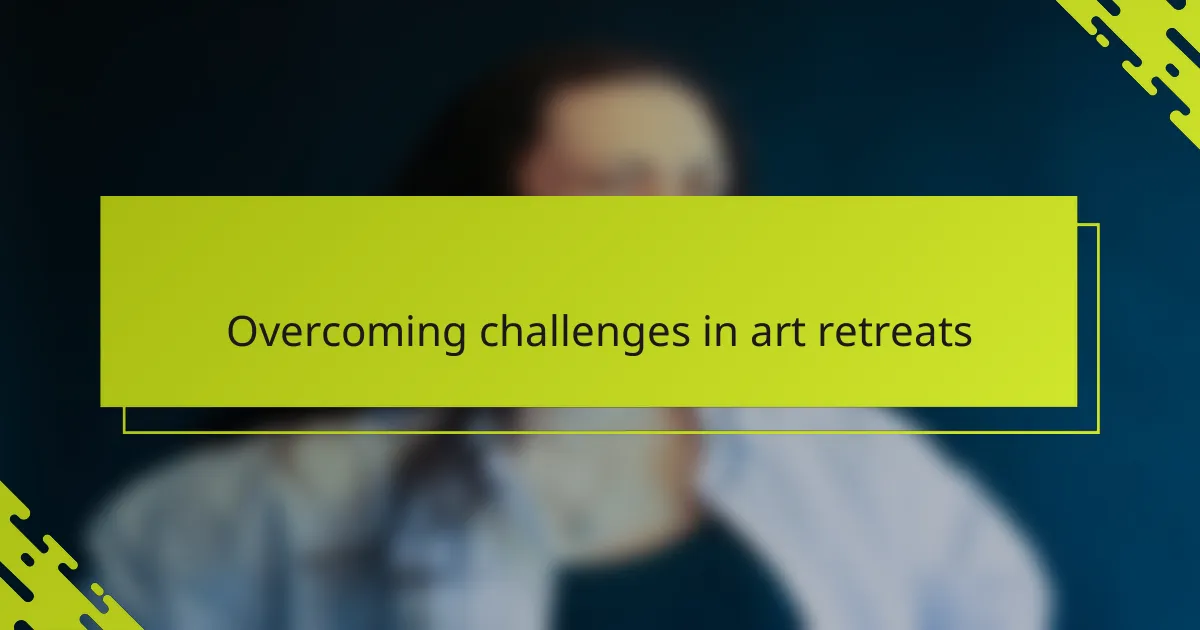
Overcoming challenges in art retreats
Challenges in art retreats often creep in unexpectedly. I recall feeling overwhelmed by the intensity of emotions that surfaced during one retreat, as creative work peeled back layers I hadn’t anticipated. Have you ever been caught off guard by how deeply art can stir your feelings in a shared space?
Navigating group dynamics can also be tricky. Even in the most welcoming environments, differences in artistic styles and personalities sometimes sparked moments of tension for me. But I found that leaning into open communication—listening without judgment—helped transform those moments into opportunities for growth. Isn’t it interesting how challenges often deepen our connections when we approach them with curiosity?
Then there’s the internal pressure to produce something “worthy” amidst so much talent and inspiration. I remember that niggling self-doubt creeping in, making me question my place in the creative circle. Over time, I learned to embrace imperfection and view the retreat as a process rather than a performance. Do you find that releasing expectations opens the door to more authentic, joyful creation?
